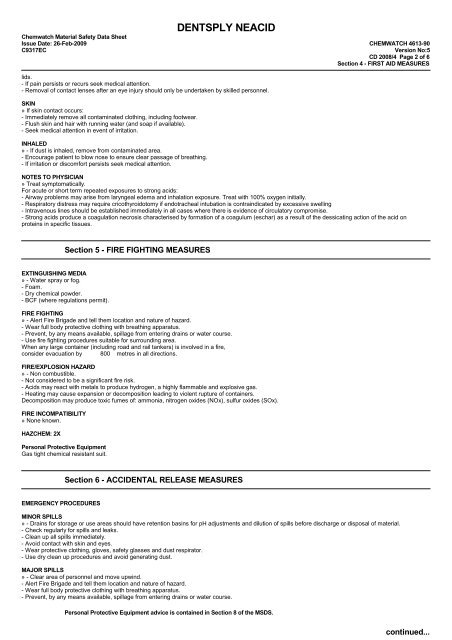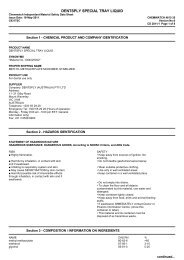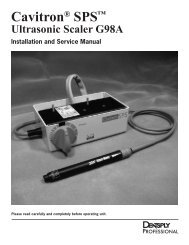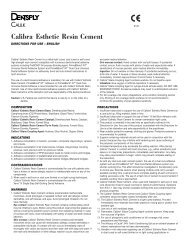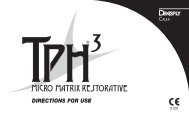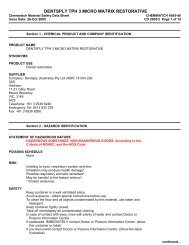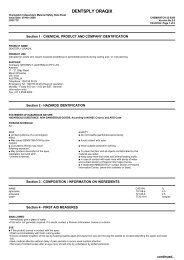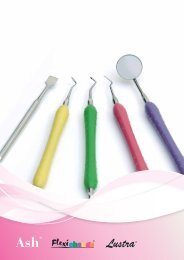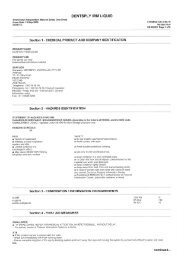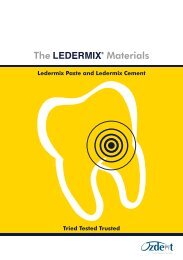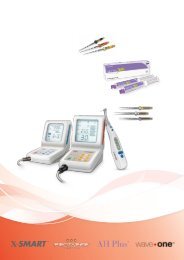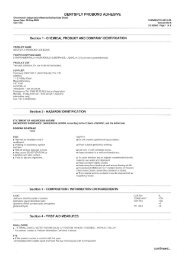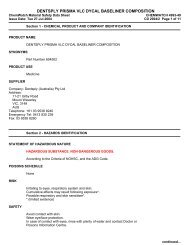Chemwatch Australian MSDS 4613-90 Dentsply Neacid
Chemwatch Australian MSDS 4613-90 Dentsply Neacid
Chemwatch Australian MSDS 4613-90 Dentsply Neacid
You also want an ePaper? Increase the reach of your titles
YUMPU automatically turns print PDFs into web optimized ePapers that Google loves.
DENTSPLY NEACID<br />
<strong>Chemwatch</strong> Material Safety Data Sheet<br />
Issue Date: 26-Feb-2009 CHEMWATCH <strong>4613</strong>-<strong>90</strong><br />
C9317EC<br />
Version No:5<br />
CD 2008/4 Page 2 of 6<br />
Section 4 - FIRST AID MEASURES<br />
lids.<br />
- If pain persists or recurs seek medical attention.<br />
- Removal of contact lenses after an eye injury should only be undertaken by skilled personnel.<br />
SKIN<br />
» If skin contact occurs:<br />
- Immediately remove all contaminated clothing, including footwear.<br />
- Flush skin and hair with running water (and soap if available).<br />
- Seek medical attention in event of irritation.<br />
INHALED<br />
» - If dust is inhaled, remove from contaminated area.<br />
- Encourage patient to blow nose to ensure clear passage of breathing.<br />
- If irritation or discomfort persists seek medical attention.<br />
NOTES TO PHYSICIAN<br />
» Treat symptomatically.<br />
For acute or short term repeated exposures to strong acids:<br />
- Airway problems may arise from laryngeal edema and inhalation exposure. Treat with 100% oxygen initially.<br />
- Respiratory distress may require cricothyroidotomy if endotracheal intubation is contraindicated by excessive swelling<br />
- Intravenous lines should be established immediately in all cases where there is evidence of circulatory compromise.<br />
- Strong acids produce a coagulation necrosis characterised by formation of a coagulum (eschar) as a result of the dessicating action of the acid on<br />
proteins in specific tissues.<br />
Section 5 - FIRE FIGHTING MEASURES<br />
EXTINGUISHING MEDIA<br />
» - Water spray or fog.<br />
- Foam.<br />
- Dry chemical powder.<br />
- BCF (where regulations permit).<br />
FIRE FIGHTING<br />
» - Alert Fire Brigade and tell them location and nature of hazard.<br />
- Wear full body protective clothing with breathing apparatus.<br />
- Prevent, by any means available, spillage from entering drains or water course.<br />
- Use fire fighting procedures suitable for surrounding area.<br />
When any large container (including road and rail tankers) is involved in a fire,<br />
consider evacuation by 800 metres in all directions.<br />
FIRE/EXPLOSION HAZARD<br />
» - Non combustible.<br />
- Not considered to be a significant fire risk.<br />
- Acids may react with metals to produce hydrogen, a highly flammable and explosive gas.<br />
- Heating may cause expansion or decomposition leading to violent rupture of containers.<br />
Decomposition may produce toxic fumes of: ammonia, nitrogen oxides (NOx), sulfur oxides (SOx).<br />
FIRE INCOMPATIBILITY<br />
» None known.<br />
HAZCHEM: 2X<br />
Personal Protective Equipment<br />
Gas tight chemical resistant suit.<br />
Section 6 - ACCIDENTAL RELEASE MEASURES<br />
EMERGENCY PROCEDURES<br />
MINOR SPILLS<br />
» - Drains for storage or use areas should have retention basins for pH adjustments and dilution of spills before discharge or disposal of material.<br />
- Check regularly for spills and leaks.<br />
- Clean up all spills immediately.<br />
- Avoid contact with skin and eyes.<br />
- Wear protective clothing, gloves, safety glasses and dust respirator.<br />
- Use dry clean up procedures and avoid generating dust.<br />
MAJOR SPILLS<br />
» - Clear area of personnel and move upwind.<br />
- Alert Fire Brigade and tell them location and nature of hazard.<br />
- Wear full body protective clothing with breathing apparatus.<br />
- Prevent, by any means available, spillage from entering drains or water course.<br />
Personal Protective Equipment advice is contained in Section 8 of the <strong>MSDS</strong>.<br />
continued...


